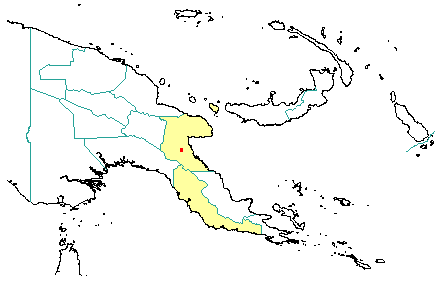
in PNGplants database
PNGTreesKey – Dendrocnide peltata (Bl.) Miq. |
Barry Conn (NSW) & Kipiro Damas (LAE).
Guide to trees of Papua New Guinea
Copyright held by the authors, National Herbarium of New South Wales, and Papua New Guinea National Herbarium
Plantae junghuhnianae 30 (1851)
Other Literature: J.J. Havel, Forest Botany, Part 2 Botanical Taxonomy 55 (1975) Fig. 13.
Family: Urticaceae
Dicotyledon
Timber Group: Non-timber species
Field Characters: Large canopy tree (up to 25 m high) or Small sub-canopy tree; Bole cylindrical (up to c. 65 cm diam.); mostly crooked; buttresses buttresses absent (fluted near base); spines spines absent; aerial roots aerial roots absent; stilt roots stilt roots absent; Bark green or grey, rough, scaly or flaky (peeling in irregular flakes) or strongly fissured; Subrhytidome (under-bark) green; less than 25 mm thick, 20.0-25.0; bark blaze consisting of one layer; faintly to non-aromatic; faintly unpleasant; outer blaze white or yellow (pale (cream-coloured), with stripes (pink fibres); inner blaze white or yellow (pale (cream-coloured), with stripes (pink fibres); bark exudate (sap) present, colourless, not readily flowing (spotty), colour not changing on exposure to air, not sticky; terminal buds not enclosed by leaves.
Indumentum: Complex hairs absent; stinging hairs present (leaves and branchlets moderately painful to touch); mature twig indumentum (hairs) present, hairs dense.
Leaves: Leaves clustered at end of branches, spiral (leaves occurring singly at a node and arranged spirally up the branchlet), simple (a leaf composed of a single blade); petiole present, not winged, attached to surface of leaf blade, not swollen; leaves broadest below middle, (13.0-) 16.0-25.0 (-30.0) cm, (8.0-) 12.0-16.0 (-20.0) cm; symmetric (slightly cordate at base), entire, not dissected or lobed, acuminate, venation pinnate or trinerved, secondary veins open, prominent, intramarginal veins absent; leaves lower surface pale green, upper surface dark green, indumentum (hairs) present, indumentum (hairs) dense; absent (densely covered with round cystoliths); domatia absent; stipules present, joined, joined across twigs, not encircling the twig, leafy, not fringed, large (10-20 mm long), persistent.
Flowers: Inflorescence axillary, flowers on a branched axis, cones absent; flowers unisexual, unisexual with male and female flowers on different plants, stalked, flowers with many planes of symmetry, 1.0-(female flowers; male flowers)-1.5 mm long, diameter small (up to10 mm diam.) (c. 1 mm diam.); perianth present, petals absent, inner perianth green (sepals); 4, free; stamens 4 (male flowers), absent or present (filaments very short), free of each other; ovary superior (female flowers), carpels joined (when more than one), locules 1; styles solitary, 1.
Fruits: Infrutescence arranged on branched axis, fruit 2.0 (c.) mm long, green or brown, not spiny, non-fleshy (nut embedded on a white to pink fleshy receptacle), simple, indehiscent, nut; seeds 1, to about 5 mm long (c. 2 mm long), not winged, broad (as wide as long) (flattened), seed 1-10 mm diam. (c. 2 mm diam.).
Distribution: Morobe or Central.
 | Botanical records in PNGplants database |
Notes: Notes W.-L. Chew (1969) Gardens' Bulletin, Singapore, 25: pp. 42-45 recognises two varieties, namely var. peltata (which occurs in Papua New Guinea and Indonesia), and var. murrayana which is restricted to the Christmas Islands.